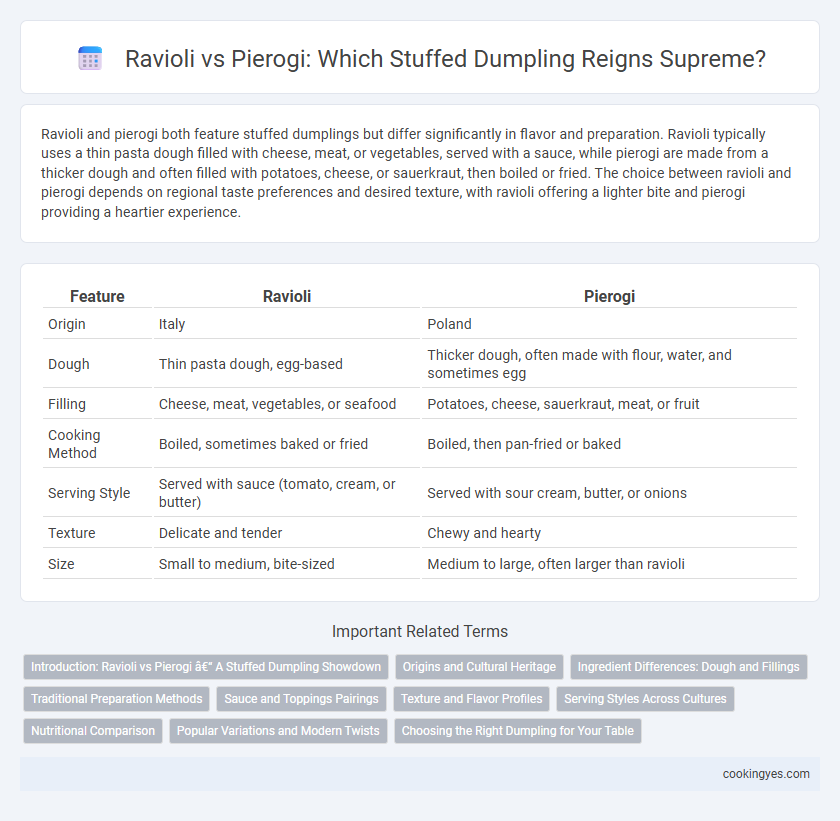Ravioli and pierogi both feature stuffed dumplings but differ significantly in flavor and preparation. Ravioli typically uses a thin pasta dough filled with cheese, meat, or vegetables, served with a sauce, while pierogi are made from a thicker dough and often filled with potatoes, cheese, or sauerkraut, then boiled or fried. The choice between ravioli and pierogi depends on regional taste preferences and desired texture, with ravioli offering a lighter bite and pierogi providing a heartier experience.
Table of Comparison
| Feature | Ravioli | Pierogi |
|---|---|---|
| Origin | Italy | Poland |
| Dough | Thin pasta dough, egg-based | Thicker dough, often made with flour, water, and sometimes egg |
| Filling | Cheese, meat, vegetables, or seafood | Potatoes, cheese, sauerkraut, meat, or fruit |
| Cooking Method | Boiled, sometimes baked or fried | Boiled, then pan-fried or baked |
| Serving Style | Served with sauce (tomato, cream, or butter) | Served with sour cream, butter, or onions |
| Texture | Delicate and tender | Chewy and hearty |
| Size | Small to medium, bite-sized | Medium to large, often larger than ravioli |
Introduction: Ravioli vs Pierogi – A Stuffed Dumpling Showdown
Ravioli and pierogi are iconic examples of stuffed dumplings, each rooted in distinct culinary traditions--Italian and Eastern European respectively. Ravioli typically feature a thin pasta dough encasing cheese, meat, or vegetable fillings, often served with rich tomato or cream-based sauces. Pierogi are usually made from unleavened dough filled with ingredients like potato, cheese, sauerkraut, or meat, and are commonly boiled and then pan-fried for a crispy finish.
Origins and Cultural Heritage
Ravioli, originating from Italy, showcases a rich culinary heritage tied to Mediterranean traditions, often filled with cheese, meat, or vegetables and served with a variety of sauces. Pierogi, rooted in Eastern European countries such as Poland and Ukraine, reflect Slavic cultural history, typically stuffed with potatoes, sauerkraut, or sweet fillings and enjoyed boiled or fried. Both dumplings highlight distinct regional flavors and historical influences, emphasizing their unique roles in Italian and Eastern European cuisines.
Ingredient Differences: Dough and Fillings
Ravioli dough is typically made from durum wheat flour and eggs, resulting in a smooth, firm texture, while pierogi dough uses all-purpose flour with water and sometimes sour cream, producing a softer, more pliable wrapper. Ravioli fillings often include a mixture of ricotta cheese, spinach, and herbs or meat-based combinations, reflecting Italian culinary traditions. Pierogi fillings favor hearty, rustic ingredients like mashed potatoes, sauerkraut, and farmer's cheese, highlighting Eastern European flavors.
Traditional Preparation Methods
Traditional preparation methods for ravioli involve rolling thin sheets of pasta dough, filling them with a mixture of ricotta, spinach, or meat, and sealing the edges before boiling. Pierogi, on the other hand, are made using unleavened dough filled with ingredients such as potatoes, sauerkraut, or cheese, typically boiled and then often pan-fried for texture. Both dumplings highlight regional ingredients and hand-crafted techniques reflecting Italian and Eastern European culinary heritage.
Sauce and Toppings Pairings
Ravioli are traditionally paired with tomato-based sauces like marinara or creamy Alfredo, which complement their thin pasta and rich fillings. Pierogi often feature toppings such as sauteed onions, sour cream, or melted butter, enhancing their thicker dough and savory or sweet fillings. Sauce choices for ravioli emphasize a balance of acidity and creaminess, while pierogi toppings highlight a more rustic, hearty flavor profile.
Texture and Flavor Profiles
Ravioli typically features a tender, smooth pasta exterior with a rich, creamy filling often made from ricotta, spinach, or meat, offering a delicate and subtly savory flavor profile. Pierogi boast a thicker, chewier dough with fillings ranging from potatoes and cheese to sauerkraut or mushrooms, resulting in a heartier texture and more robust, earthy taste. The contrast in dough thickness and filling ingredients highlights ravioli's refined softness against pierogi's rustic, dense consistency and bold flavors.
Serving Styles Across Cultures
Ravioli, traditional Italian stuffed dumplings, are commonly served with rich tomato or creamy Alfredo sauces, often garnished with Parmesan cheese and fresh herbs, highlighting Mediterranean flavor profiles. Pierogi, a staple in Eastern European cuisine, are typically boiled and then pan-fried, served with sour cream, caramelized onions, or bacon bits, reflecting Slavic hearty and comforting tastes. These distinct serving styles emphasize cultural preferences in texture, accompaniments, and presentation, underscoring the culinary heritage behind each stuffed dumpling variety.
Nutritional Comparison
Ravioli and pierogi, both popular stuffed dumplings, differ notably in their nutritional profiles. Ravioli, typically filled with cheese, meat, or vegetables, tends to be higher in protein and calcium due to cheese-based fillings, whereas pierogi often contain potatoes, sauerkraut, or sweet fillings, contributing to higher carbohydrate and fiber content. Pierogi made with whole wheat dough can offer more dietary fiber compared to traditional wheat-based ravioli, making them a better choice for digestive health.
Popular Variations and Modern Twists
Ravioli, originating from Italian cuisine, features popular variations such as spinach and ricotta filling, meat-stuffed versions, and creative modern twists like pumpkin or seafood fillings paired with gourmet sauces. Pierogi, a traditional Polish dumpling, often comes filled with potatoes, cheese, sauerkraut, or mushrooms, and has evolved to include sweet fillings like berries or chocolate. Modern twists on both dishes embrace fusion influences, incorporating global ingredients, innovative cooking techniques, and presentation styles that elevate these classic stuffed dumplings.
Choosing the Right Dumpling for Your Table
Ravioli and pierogi both offer unique flavors and fillings, shaping the perfect choice for your table based on regional tastes and texture preferences. Ravioli, with its thin pasta sheets and diverse fillings like ricotta or spinach, suits those favoring a delicate, Italian-inspired dish. Pierogi, known for thicker dough and hearty fillings such as potatoes and cheese, aligns well with rustic Eastern European comfort food traditions.
Ravioli vs Pierogi for stuffed dumplings Infographic

 cookingyes.com
cookingyes.com